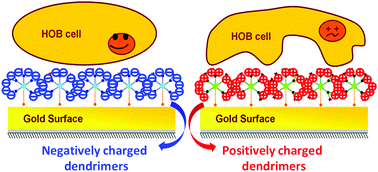Synthesis and characterization of bifunctional dendrimers: preliminary use for the coating of gold surfaces and the proliferation of human osteoblasts (HOB)†
Abstract
Two different novel families of bifunctional water-soluble dendrimers are synthesized, using the specific functionalization of one function of the cyclotriphosphazene core. Dendrimers are grown from the 5 remaining functions, up to generation 2. Water-solubility is attained in the last step of the synthesis by grafting either ammonium terminal groups or carboxylate terminal groups, on generations 1 and 2 of these bifunctional dendrimers. 12 new compounds are synthesized and fully characterized, in particular by multi-nuclear NMR. The function linked to the core is thioctic acid, suitable for grafting onto gold, thus both types of water-soluble dendrimers can be used to coat gold surfaces. These macromolecular assemblies are characterized by surface plasmon resonance (SPR). In a preliminary attempt, the gold surfaces modified by either positively or negatively charged dendrimers are used for studying their interaction with cells. Exposed to human osteoblast cells (OBC), the influence of the surface coatings on the cell responses is investigated. Polycationic dendrimers provoke cell apoptosis, whereas negatively charged dendrimers support cell adhesion and proliferation.


 Please wait while we load your content...
Please wait while we load your content...